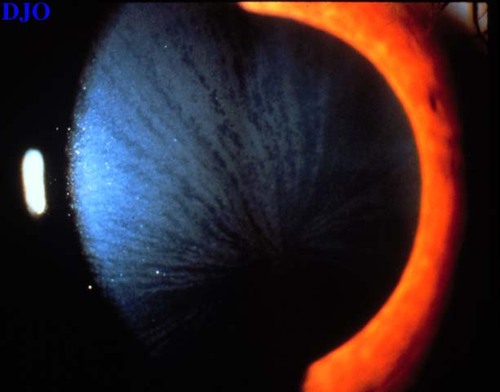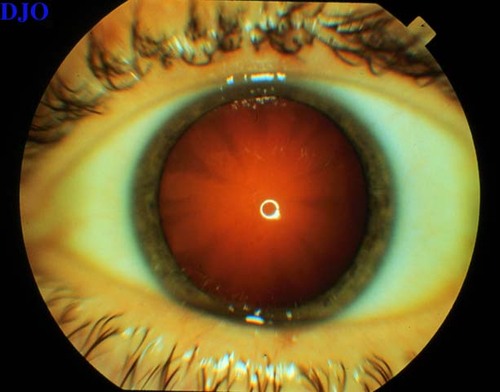Cornea/Refractive Surgery Quiz 20

Figure 1
Figures 1-2. Anterior segment photographs of 2 different patients with the same condition. (Courtesy Kenneth Kenyon MD, John Loewenstein MD)
Figures 1-2. Anterior segment photographs of 2 different patients with the same condition. (Courtesy Kenneth Kenyon MD, John Loewenstein MD)

Figure 2
Answer: The first photograph demonstrates whorl like subepithelial deposits characteristic of corneal verticillata. The second photograph shows radial wedges of anterior subcapsular opacification. Together these findings support the diagnosis of Fabry disease.
2. What else may produce these corneal findings?
Answer: Corneal verticillata is characteristic of Fabry disease however it may also bee seen with long term use of systemic medications such as amiodarone, chloroquine, chlorpromazine, and indomethacin.
3. What causes this disease?
Answer: Fabry disease is an X-linked recessive error of glycosphingolipid metabolism that results in accumulation of neutral glycosphingolipid in cellular lysosomes. Vascular endothelium is particularly sensitive to glycosphingolipid deposition, and endothelial damage contributes to much of the pathology in Fabry disease.
4. What systemic findings might be expected?
Answer: The major manifestations of Fabry disease in hemizygous males include, vascular disease of the heart, brain, peripheral nerves, skin, kidneys, and eyes. Vascular compromise affecting the heart may lead to ischemic heart disease. The central nervous system may be affected leading to seizures, transient ischemic attacks, and ischemic stroke. Peripheral and autonomic neuropathy are common in Fabry disease. Fabry disease patients also develop characteristic ectasia of skin vessels called angiokeratoma. Progressive renal failure is a classic finding in Fabry disease.
5. What are the other ocular manifestations of this disorder?
Answer: In addition to corneal verticillata and anterior subcapsular cataract, patients with Fabry disease also may have spoke like posterior subcapsular cataract. Aneurysmal dilatations of conjunctival veins, and retinal vascular tortuousity is also common in Fabry disease. Central retinal artery occlusion is uncommon, but is a serious complication that can result FROM the vascular endothelial abnormality.